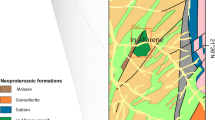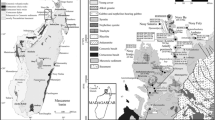Abstract
The Sintra igneous complex, Portugal was an important centre of activity in late Cretaceous times. The great proportion of thealkaline rocks are felsic and include five large quartz syenite intrusions and trachyandesite, trachyte and alkali rhyolite lavas and dykes, most of which are oversaturated. Mafic rocks are sparse, but vary widely from alkaline and highly undersaturated types containing high K2O, TiO2 and Ba, similar to the contemporaneous Lisbon lavas, to hypersthene normative trachybasalts and one hypersthene normative basalt. The various magma types are intimately associated and a well-developed netveined complex of alkali gabbro, monzonite and syenite is recognised at Cabo da Roca. A study of the dyke distributions, intersections and orientations suggest a close propinquity of both oversaturated and undersaturated and of both felsic and matic magmas.
The basic magmas of Sintra and Lisbon show a continuous range in undersaturation (0 to 16% normative nepheline) and rare hypersthene normative basalts. Derivation of the hypersthene normative and mildly undersaturated basalts from the more undersaturated melts by low pressure fractionation or contamination by siliceous crust is shown to be unlikely. High pressure eclogite fractionation of a hypersthene normative basalt or variations in the percentage partial melting of a mantle under conditions where titanphlogopite is a low melting fraction are both processes compatible with the variations in undersaturation and proportions of TiO2, K2O and Ba. The quartz syenites and over satured felsic lavas of Sintra are thought to be derived from hypersthene nor mative parents.
Similar content being viewed by others
References
Aoki, K., 1963,Kaersutites and Oxykaersutites from Alkalic Rocks of Japan and Surrounding Areas. J. Petrol.,4, p. 198–210.
Baker, I., 1968,Compositional Variation of Minor Intrusions and the Form of a Volcano Magma Chamber. Quat. J. Geol. Soc. London,124, 493 pp.
Baker, P. E., Gass, I. G., Harris, P. G. andLe Mattre, R. W., 1964,The Volcanological Report of the Royal Society Expedition to Tristan da Cunha, 1962. Philos. Trans. Roy. Soc. Lond. A,256 (1075), p. 439–578.
Blake, D. H., Elwell, R. W. D., Gibson, I. L., Skelhorn, R. R. andWalker, G. P. L., 1964,Some Relationships Resulting from the Intimate Association of Acid and Basic Magmas. Quat. J. Geol. Soc.,121, p. 31–49.
Cox, G., Gass, I. G. andMallick, D. I. J., 1970,The Peralkaline Volcanic Suite of Aden and Little Aden, South Arabia. Jour. Petrol.,11 (3), p. 433–61.
Flower, M. F. J., 1971,Evidence for the Role of Phlogopite in the Genesis of Alkali Basalts. Contr. Mineral. and Petrol.,32, p. 126–237.
Forbes, W. C. andFlower, M. F. J., 1974,Phase Relations of Titan-phlogopite K2 Mg4 Ti Al2 Si6 O20 (OH)4:A Refractory Mineral in the Upper Mantle? Earth and Planet. Sci. Letters,22, p. 60–66.
Gast, P. W., 1968,Trace Element Fractionation and the Origin of Tholeiitic and Alkaline Magma Types. Geochimica et Cosmochimica Acta,32 (10), p. 1057–1086.
Irvine, T. N. andBaragar, W. R. A., 1971,A Guide to the Chemical Classification of the Common Volcanic Rocks. Can Journ. Earth Sci.,8 (5), p. 523–548.
Kesson, S. andPrice, R. C., 1972,The Major and Trace Element Chemistry of Kaersutite and Its Bearing on the Petrogenesis of Alkaline Rocks. Contrib. Mineral. and Petrol.,35, p. 119–124.
Matos Aines, C. A., 1964,Estudo Petrologico Do Macico Eruptive de Sintra. Rev. Fac. Cienc. Lisbon, Ser. 2, C. 12, p. 123–289.
O’Hara, M. J., 1968,The Bearing of Phase Equilibria Studies in Synthetic and Natural Systems on the Origin and Evolution of Basic and Ultrabasic Rocks. Earth-Sci. Rev.,4, p. 69–133.
Schmincke, H. U. andWeibel, M., 1972,Chemical Study of Rocks from Madeira, Porto Santo and San Miguel, Teceira (Azores). N. Jb. Miner. Abh.,117, p. 253–281.
Thompson, R. N., Esson, J. andDuniiam, A. C., 1972,Major Element Chemical Variation in the Eocene Lavas of the Isle of Skye, Scotland. Journ. of Petrol.,13 (2), p. 219–253.
Upton, B. G. J. andWadsworth, W. J., 1972,Aspects of the Magmatic Evolution on Reunion Island. Phil. Trans. R. Soc. Lond. A.,271, p. 103–130.
Wright, J. B., 1968,Re-interpretation of a Mixed Petrographic Province — the Sintra Intrusive Complex (Portugal) and Related Rocks. Geol. Rundsch.,58 (2), p. 538–559.
Yagi, K., 1953,Petrochemical Studies on the Alkalic Rocks of the Moruitt District, Sakhalin. Bull. Geol. Soc. Amer.,64 (7), p. 769–810.
Author information
Authors and Affiliations
Rights and permissions
About this article
Cite this article
Sparks, R.S.J., Wadge, G. Geological and geochemical studies of the sintra alkaline igneous complex, portugal. Bull Volcanol 39, 385–406 (1975). https://doi.org/10.1007/BF02597263
Received:
Revised:
Issue Date:
DOI: https://doi.org/10.1007/BF02597263




